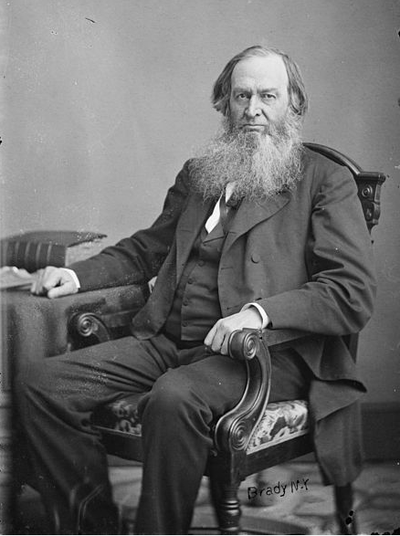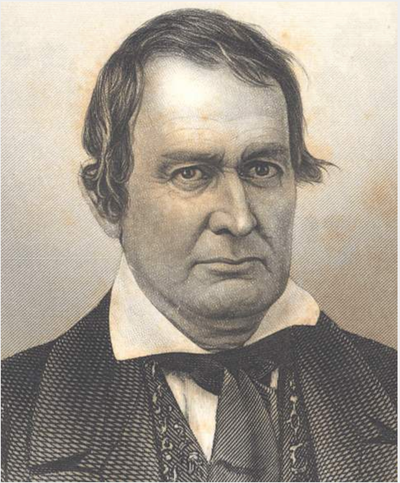Gerrit Smith
Abolitionist
Background
He received all his father's property, which was valued at about $400,000. He later was able to increase the property in size and value. With this new found money Smith used it to do as much as he could, in “helping mankind”. He helped build Churches and gave money to theological schools and colleges. He was elected to the U.S. House of Representatives as an independent in 1852. He resigned his seat in 1854 at the end of his first session.
His interests soon drifted into the backing of the Abolitionist Movement. In which he became friends with John Brown and Frederick Douglass. He soon picked up many leadership roles in the movement along the way. He became an avid Supporter of the Union. He also was an important financial backer for many other Abolitionists like Brown and Douglass. Smith used his money and power in order to make a change in the community.

Participation in the Abolitionist movement
Smith became an abolitionist in 1835, "after witnessing the disruption of an antislavery meeting by a mob in Utica.” (Encyclopedia-Library of Congress). He also joined the anti-slavery crusade around the same time. He was elected as a member of congress on March 4th, 1853. He used his political power to help "Eli Thayer's New England Emigrant Aid Company in Massachusetts." (Dictionary of American Biography-Gale in Context). He also used his platform as a voice for slaves who were not given one. He resigned on August 7th, 1854. When resigning he spoke in support of the union.
However he was not just a political figure. He gave 50 acres of land to many farms, of indigent families. He also tried to colonize tracts in northern New York with free blacks, but this experiment was a failure. He sold John Brown and his family land at North Elba, NY. Brown's family was supposed to use this land to help the new settlers to become productive farmers. Along the way he became close friends with Frederick Douglas, and gave money in support of the publication of Douglass's paper; The North Star. “Under the excitement following the raid on Harpers Ferry in October 1859, he became temporarily insane, and for several weeks was confined in an asylum in Utica.” (Encyclopedia-Library of Congress). After a short time confined in an asylum, he was fine. Later in 1867, he signed for the release of Jefferson Davis from Captivity. He did this as he thought all people deserve the right to a just and speedy trial. He believed all people deserved the same.
Smith played an important role in the start of the Civil War, and was an adamant supporter of the Union. He believed all people were the same, and should be treated accordingly. He spent his livelihood in hope of a better life for enslaved African Americans.

Timeline
Born
03/06/1797He became an abolitionist
He became an abolitionist in 1835, after witnessing the disruption of an antislavery meeting by a mob in Utica.”
01/01/1835U.S. House of Representatives Election
He was elected to the U.S. House of Representatives as an independent in 1853
03/04/1853Resignation from the house
He resigned his seat in 1854 at the end of his first session.
08/07/1854Harpers Ferry Raid
Under the excitement following the raid on Harpers Ferry in October 1859, he became temporarily insane, and for several weeks was confined in an asylum in Utica.
10/16/1859Jefferson Davis Released
In 1867 he was one of the signers of the bail bond to release Jefferson Davis from captivity.
05/01/1867Died
Died visiting family in New York
12/28/1874Bibliography
Citations
The Editors of Encyclopedia Britannica. “Gerrit Smith.” Encyclopedia Britannica, Encyclopedia Britannica, Inc., 2 Mar. 2019, www.britannica.com/biography/Gerrit-Smith.
Knoblauch, Edward H. “Gerrit Smith - Biographical Information.” New York History Net, Niagara University, 2008, www.nyhistory.com/gerritsmith/smith.htm.
"Gerrit Smith." Dictionary of American Biography, Charles Scribner's Sons, 1936. Gale In Context: Biography, https://link.gale.com/apps/doc/BT2310003307/BIC?u=west66701&sid=BIC&xid=53522ea7. Accessed 11 Dec. 2019.
Pictures
Home Page:
An 1866 photograph of Gerrit Smith. Image credit: Alonzo Pease, “Gerrit Smith” Retrieved from Oswego Public Library, https://www.oswegopubliclibrary.org/node/121
Abolitionist Page:
An 1854 engraving of Gerrit Smith Image credit: John Chester Buttre, “Smith, Gerrit.” Retrieved from Dickinson College, http://hd.housedivided.dickinson.edu/node/15155
